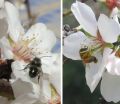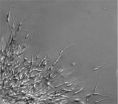(Press-News.org) Agricultural demand for pollination is growing more quickly than the supply of honey bees, the dominant species managed for crop pollination. Increasing the efficiency of pollination represents a way of increasing crop yield without any increase in agricultural intensity or area. A study recently published in the Proceedings of the Royal Society B: Biological Sciences (9 Jan 2013) 1, shows that the pollination effectiveness of honey bees in California almond orchards was greater in the presence of other bees.
Almond is a crop highly dependent on honey bee pollination and is a $3 billion industry in California. The study by researchers in Germany at Leuphana University of Lüneburg and California at UC Berkeley and Davis found that where other species of bees were present, honey bee behaviour changed and their pollination effectiveness was greater than in orchards where other bees were absent. Furthermore, orchards with wild bees had a greater proportion fruit set. These findings show that wild pollinators not only contribute directly to almond pollination, but also indirectly through increasing the pollination service provided by the honey bees.
A second study in the same system published in Global Change Biology (27 Nov 2012)2 found two other mechanisms by which pollinator diversity improved pollination service to almond. Firstly, they found that honey bees preferred to visit flowers in the top parts of the almond trees. Where wild pollinators were present, they often visited the lower parts of the trees, filling the gap in pollination service left by the honey bees. Secondly, in high winds, orchards with only honey bees present had almost no pollination service as the honey bees were not flying. In orchards with a diversity of pollinators, pollination service was buffered to an extent by the wild bees.
During high winds, the wild bees were still observed visiting almond flowers. Wild pollinators can therefore help sustain pollination service under extreme weather conditions, when the service by honey bees declines. This is particularly important in almond as it flowers early in the year when the weather conditions can be unfavourable for bee flight. The findings presented in the two articles highlight different ways biodiversity is important for pollination service.
The researchers presenting the studies are Alexandra-Maria Klein and Claire Brittain from Leuphana University of Lüneburg, Claire Kremen from UC Berkeley and Neal Williams from UC Davis.
INFORMATION:
Original sources
Brittain, C., Williams, N., Kremen, C. & Klein, A.M. (2013) Synergistic effects of non-Apis bees and honey bees for pollination services. Proceedings of the Royal Society B. doi: 20122767
Brittain, C., Kremen, C. & Klein, A.M. (2012) Biodiversity buffers pollination from changes in environmental conditions. Global Change Biology, 19, 540-547. doi: 10.1111/gcb.12043
Contacts
USA:
Dr. Claire Brittain
Department of Entomology
University of California
Davis, CA 95616
USA
Europe:
Prof. Alexandra-Maria Klein
Ecosystem Functions
Institute of Ecology
Faculty Sustainability
Leuphana University of Lüneburg
Scharnhorststrasse 1
21335 Lüneburg
Germany
Email: aklein@uni-leuphana.de
phone: 49-413-167-729-60.
Posted by Pensoft Publishers.
2 new studies show why biodiversity is important for pollination services in California almond
2013-01-14
ELSE PRESS RELEASES FROM THIS DATE:
How does your garden glow?
2013-01-14
Nature's ability to create iridescent flowers has been recreated by mathematicians at The University of Nottingham. The team of researchers have collaborated with experimentalists at the University of Cambridge to create a mathematical model of a plant's petals to help us learn more about iridescence in flowering plants and the role it may play in attracting pollinators.
An iridescent surface appears to change colour as you alter the angle you view it from. It is found in the animal kingdom in insects, inside sea shells and in feathers, and is also seen in some plants. ...
How do happiness and sadness circuits contribute to bipolar disorder?
2013-01-14
Philadelphia, PA, January 14, 2013 – Bipolar disorder is a severe mood disorder characterized by unpredictable and dramatic mood swings between the highs of mania and lows of depression. These mood episodes occur among periods of 'normal mood', termed euthymia.
Prior research has clearly shown that brain emotion circuitry is dysregulated in individuals diagnosed with bipolar disorder. It is thought that these disturbances impair one's ability to control emotion and contribute to mood episodes.
Continuing this line of research, the January 15th issue of Biological Psychiatry ...
Global warming has increased monthly heat records by a factor of 5
2013-01-14
Monthly temperature extremes have become much more frequent, as measurements from around the world indicate. On average, there are now five times as many record-breaking hot months worldwide than could be expected without long-term global warming, shows a study now published in Climatic Change. In parts of Europe, Africa and southern Asia the number of monthly records has increased even by a factor of ten. 80 percent of observed monthly records would not have occurred without human influence on climate, concludes the authors-team of the Potsdam Institute for Climate Impact ...
Protein identified that can disrupt embryonic brain development and neuron migration
2013-01-14
Interneurons – nerve cells that function as 'dimmers' – play an important role in the brain. Their formation and migration to the cerebral cortex during the embryonic stage of development is crucial to normal brain functioning. Abnormal interneuron development and migration can eventually lead to a range of disorders and diseases, from epilepsy to Alzheimer's. New research by Dr. Eve Seuntjens and Dr. Veronique van den Berghe of the Department of Development and Regeneration (Danny Huylebroeck laboratory, Faculty of Medicine) at KU Leuven (University of Leuven) has identified ...
Research makes connetion between tubal ligation and increase in cervical cancer rates
2013-01-14
Women who have a tubal ligation – the surgical tying or severing of fallopian tubes to prohibit pregnancy – have less frequent Pap smears, which puts them at an increased risk for cervical cancer, according to research recently released by a team that included Cara A. Mathews, MD, a gynecologic oncologist at the Program in Women's Oncology at Women & Infants Hospital of Rhode Island.
The findings were part of the National Cancer Institute-funded study "Study to Understand Cervical Cancer Endpoints and Determinants" being conducted when Dr. Mathews was a fellow at the ...
Liver controls wasting in cancer
2013-01-14
Cachexia or wasting is a condition affecting up to 70 percent of cancer patients, depending on the type of cancer. It is characterized by a dramatic loss of body weight that is independent of food intake. Cachexia is seen particularly often and most pronounced in patients suffering from cancers of the digestive tract and the lungs. They may lose up to 80 percent of body fat and skeletal muscle. Muscle loss leads to weakness and immobility of patients and poorer response to treatment. An estimated 20 percent of cancer deaths are considered to be a direct consequence of cachexia, ...
Dynamic, dark energy in an accelerating universe
2013-01-14
This press release is available in Spanish.
It was cosmology that drew Irene Sendra from Valencia to the Basque Country. Cosmology alsogave her the chance to collaborate with one of the winners of the 2011 Nobel Prize for Physics on one of the darkest areas of the universe. And dark matter and dark energy, well-known precisely because so little is known about them, are in fact the object of the study bySendra, a researcher in the Department of Theoretical Physics and History of Science of the UPV/EHU's Faculty of Science and Technology.
"Observations tell us that ...
NRL designs multi-junction solar cell to break efficiency barrier
2013-01-14
WASHINGTON -- U.S. Naval Research Laboratory scientists in the Electronics Technology and Science Division, in collaboration with the Imperial College London and MicroLink Devices, Inc., Niles, Ill., have proposed a novel triple-junction solar cell with the potential to break the 50 percent conversion efficiency barrier, which is the current goal in multi-junction photovoltaic development.
"This research has produced a novel, realistically achievable, lattice-matched, multi-junction solar cell design with the potential to break the 50 percent power conversion efficiency ...
Using lysine estimates to detect heat damage in DDGS
2013-01-14
URBANA – Distillers dried grains with solubles (DDGS) are a good source of energy and protein in swine diets. However, they can be damaged by excessive heat during processing, compromising their nutritional value. University of Illinois researchers have found that it is possible to assess heat damage by predicting the digestibility of lysine in DDGS.
Excessive heat causes some of the lysine in DDGS to bond with sugars and form Amadori compounds. The lysine bound in these compounds is called unreactive lysine; pigs cannot digest it. Lysine that is not bound is referred ...
Amino acid studies may aid battle against citrus greening disease
2013-01-14
This press release is available in Spanish.Amino acids in orange juice might reveal secrets to the successful attack strategy of the plant pathogen that causes citrus greening disease, also known as Huanglongbing or HLB. Studies of these amino acids by U.S. Department of Agriculture (USDA) chemist Andrew P. Breksa III and University of California-Davis professor Carolyn M. Slupsky may pave the way to a safe, effective, environmentally friendly approach to undermine Candidatus Liberibacter asiaticus, the microbial culprit behind HLB.
The scientists used nuclear magnetic ...



